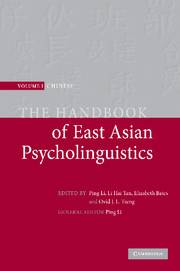Book contents
- Frontmatter
- Contents
- List of figures
- Notes on contributors
- Preface
- Introduction: new frontiers in Chinese psycholinguistics
- Part I Language acquisition
- Part II Language processing
- Part III Language and the brain
- 25 The relationship between language and cognition
- 26 Language processing in bilinguals as revealed by functional imaging: a contemporary synthesis
- 27 Specific language impairment in Chinese
- 28 Brain mapping of Chinese speech prosody
- 29 Modeling language acquisition and representation: connectionist networks
- 30 The manifestation of aphasia syndromes in Chinese
- 31 Naming of Chinese phonograms: from cognitive science to cognitive neuroscience
- 32 How the brain reads the Chinese language: recent neuroimaging findings
- Epilogue: a tribute to Elizabeth Bates
- References
- Name index
- Subject index
29 - Modeling language acquisition and representation: connectionist networks
Published online by Cambridge University Press: 05 June 2012
- Frontmatter
- Contents
- List of figures
- Notes on contributors
- Preface
- Introduction: new frontiers in Chinese psycholinguistics
- Part I Language acquisition
- Part II Language processing
- Part III Language and the brain
- 25 The relationship between language and cognition
- 26 Language processing in bilinguals as revealed by functional imaging: a contemporary synthesis
- 27 Specific language impairment in Chinese
- 28 Brain mapping of Chinese speech prosody
- 29 Modeling language acquisition and representation: connectionist networks
- 30 The manifestation of aphasia syndromes in Chinese
- 31 Naming of Chinese phonograms: from cognitive science to cognitive neuroscience
- 32 How the brain reads the Chinese language: recent neuroimaging findings
- Epilogue: a tribute to Elizabeth Bates
- References
- Name index
- Subject index
Summary
Connectionism, Parallel Distributed Processing (PDP), or neural networks have had a profound impact on cognitive sciences in the last two decades. Language, as one of the central human cognitive components, has received in-depth treatments since the beginning of connectionist research. The acquisition of the English past tense (Rumelhart & McClelland, 1986), the recognition of speech (McClelland & Elman, 1986), and the processing of sentences (McClelland & Kawamoto, 1986) are among the earliest domains of connectionist research in the original PDP models. Connectionism has since been applied to the study of many domains involving language, including language acquisition, normal and impaired word reading, and language organization in the brain (e.g. Elman et al., 1996; Plaut et al., 1996; Miikkulainen, 1997; Small et al., 1995). Unfortunately, connectionist models or modeling have had very limited influences on Chinese psycholinguistics as a whole. To date, there are very few connectionist models that are designed specifically to account for the processing or representation of the Chinese language. This lack of interaction between connectionism and Chinese psycholinguistics is lamentable. On the other hand, however, this lack opens new avenues for research. In this chapter, I present research from our laboratories that explores the issue of linguistic representations and acquisition in connectionist networks, with particular reference to Chinese, in both monolingual and bilingual contexts.
Connectionism: an overview
Connectionist representation and learning
A close parallel has been drawn between the human mind and the digital computer in the classical conceptualization of human cognition.
- Type
- Chapter
- Information
- The Handbook of East Asian Psycholinguistics , pp. 320 - 329Publisher: Cambridge University PressPrint publication year: 2006
- 2
- Cited by



